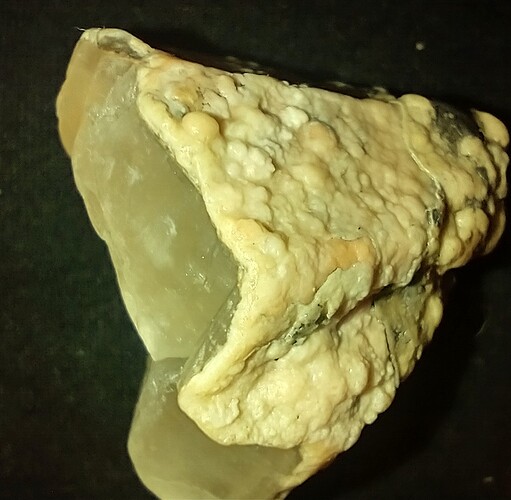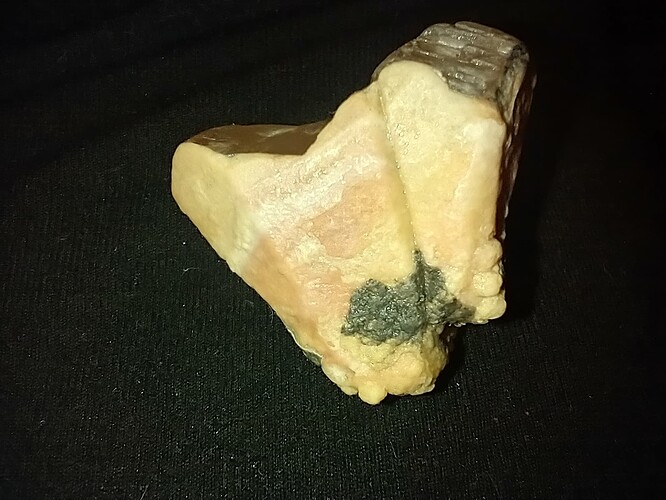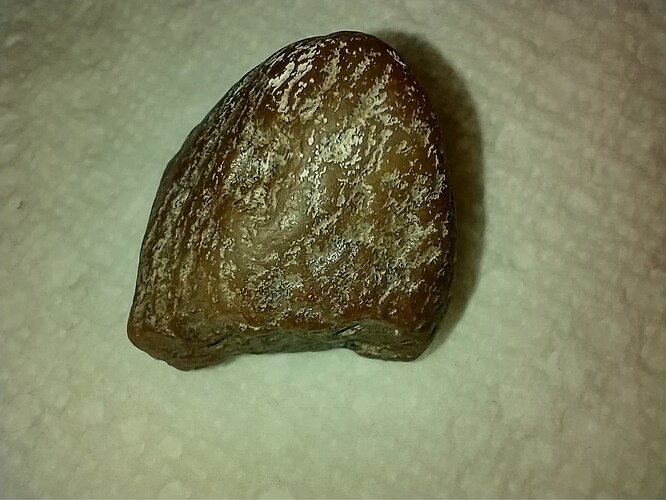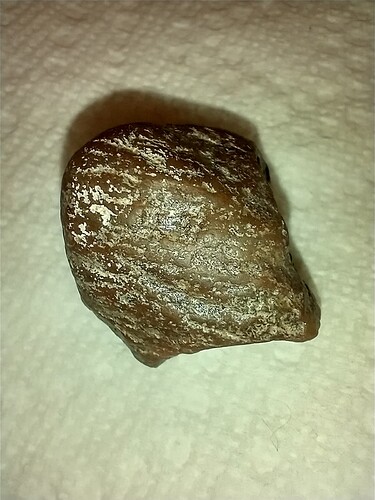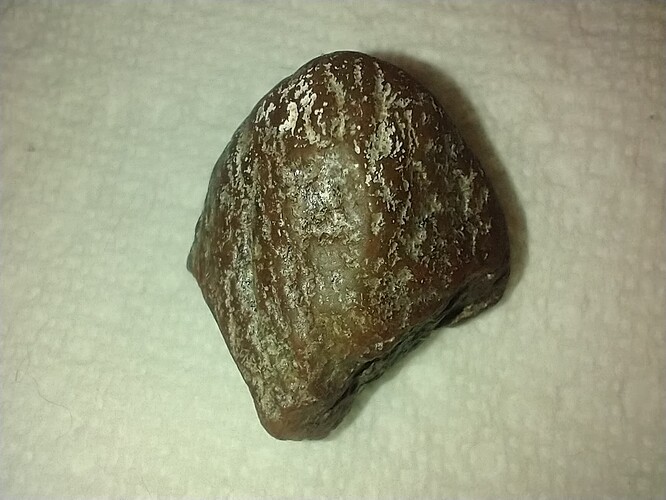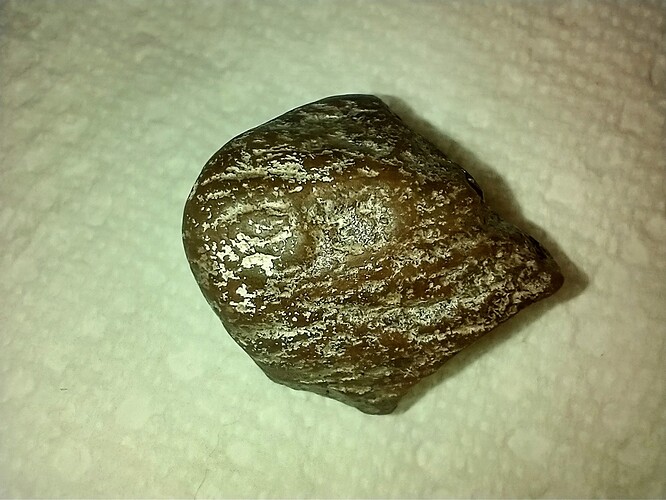Hello Everyone,
I would love some help identifying an interesting crystal I found about two years ago. The specific gravity is: 25.2g/9.3cm= 2.73913043 or 2.74g/cm³
I’ve never seen anything like this. It’s got a shell around the clear crystals. Hoping it is familiar to someone!
Thank you in advance.
Hinde
My initial thoughts on it are calcite crystals inside limestone perhaps? Looking forward to hearing from others when you get a chance. Thanks 
Here’s another one for identification. It’s more lavender than it looks in the photos but I think it is sugilite. The specific gravity checks out and I feel about 90% certain but I would like to hear others opinions.
Hi. I saw you post about not receiving any replies on this topic. These pictures are good, but not so helpful in identifying either of these items. Also, it appears to me that you may be taking your specific gravity readings inaccurately.
Specific Gravity in relation to minerals and gems is a tricky test when the specimen contains several types of materials. For instance, in your 1st item appears to have a crystal structure with some type of overgrowth and a metallic mineral. I recommend only using hydrostatic weighing with finished gemstones for more accurate results.
The method for hydrostatic weighing is as follows. This is taken directly from the GIA Gem Identification Lab Manual.
“When a gem is immersed in water, its weight is different from its weight in air. Immersion forces a volume of water that’s equal to the gem’s size out of the way. The difference between the gem’s weight in air and its weight in water is equal to the weight of the water that the gem displaces. When you divide the object’s weight in air by the weight of the water it displaces, you end up with its Specific Gravity (SG). This process is called hydrostatic weighing.”
SG = weight in air / (weight in air - weight in water)
I hope this is helpful information for you.
1 Like
Hi there, and thanks for the reply.
I think my SG looks confusing because I showed the result prior to rounding it off, I should
have just written the end result, which is 2.74 g/cc for each of
the two crystals posted here. What would you recommend in terms of
the type of photos, that would help with improving identification help?
Thank you for the advice regarding specimens that contain different materials,
I always wondered how to accurately measure the SG for these types of crystals,
so you’re saying it won’t be accurate unless it has been faceted or separated into
one material?
Any thoughts about what that first one with the crystals inside of
some sort of cone-like shaped material might be? Have you ever seen
anything like it?
Lastly, I think the second specimen is not sugilite, but rather lepidolite.
Rounding off the digits isn’t the problem. You are not calculating SG correctly, there is no need for the 9.3cm figure.
Take the weight of your item “minus” what it weighs in water = X
Specific Gravity = Weight in air “divided by” X
SG is also not very accurate, I usually only use SG in identification when I want to confirm it is what I think it is. The tricky part about that particular test is if your item has tiny crevasses for air to get stuck while it is submerged. Those air pockets will completely ruin any hope that you get an accurate result. This is often too difficult to determine with rough specimens, which is why I recommend only using SG when you have a finished gemstone or something that has been worked. You’ll get more accurate results that way.
1 Like
I divide the weight of the specimen in grams by the weight of the specimen in grams as it is suspended in a zeroed-out (tare) container of water. So you’re saying this is not the correct way to measure SG?
SpG is defined by the RATIO of weight in air versus the weight in water. the WEIGHT of the VOLUME of DISPLACED water is the key factor… that’s Archimedes principle…the prior post is absolutely correct in that it’s not suited at all for rough specimens…air pockets, other minerals present in a rough rock will give you inaccurate results. That is why it’s done on cut and or finished stones. if volume displacement of water is counter intuitive, because a large stone will displace more water than a small one, remember that it’s a ratio and not absolute numbers…water is the standard as a liter of water at 25 degrees C weighs 1 kilogram. to do home SpG measurements you need to have a sensitive and accurate balance, not a spring scale, and weight the stone in air then immerse it in water and weigh it again…SpG is just a rough guide to stone ID… SpG is actually the density (weight divided by volume) of a mineral which has a range. Other techniques such as Moh’s hardness also can show a range for a mineral…the scale is nonlinear. It too is a screening field test. Same goes for streak and any other field testing methods, such as using dilute hydrochloric acid for carbonate rocks.
Now I am deliberately going over your head in order to let you know how involved rock and mineral ID is…this is about techniques that are very accurate are far beyond the capability of home testing. Some of them are X ray fluorescence, Raman spectroscopy, optical spectroscopy, electron microprobe, and ultimately mass spect. These techniques are extremely precise and accurate but require specialized equipment. Outside of university geology labs, only large organizations like the GIA have them.
Rock ID is an entirely different beast than is mineral crystal ID…rocks are composed of more than one mineral, although some come close to all quartz. The only way to accurately ID a rock is to have it cut into thin section and examine the individual mineral grains in a petrological microscope and count them…each mineral within the thin section can be identified by optical properties. Plane polarized light is used and the filter rotated to determine the angle of extinction of each mineral… the angle of extinction gives you the refractive index and crystal axes of each mineral grain… the process is tedious since all of the grains within a field have to be counted and tallied up as they are identified. This method identifies a rock by what is called the MODE or modal analysis… rocks can be further analyzed chemically. all of the cations such as Ca, Na, K, aluminum, silicon are recalculated as oxides. Specific minerals then reconstructed out of oxides thru an algorithm. This technique gives you the CIPW NORM or normative analysis… all these two methods are still in use, particularly modal analysis, which is the first step… normative analysis has been supplanted by high tech methods- electron microprobe and laser ablation mass spectrometry. These techniques are used to very accurately measure the chemical composition of rocks and minerals, and even provide isotopic analysis for dating the age of a rock or mineral. The GIA has the same machines which cost over a million dollars for mass spect… GIA researchers are using high tech methods to develop technique to detect fraud in the gem market and bring order to it, which is part of their stated mission.
I’m letting you know about these things because rock and mineral ID is quite involved. This is all probably over your head. It just goes to show that sometimes it’s easy and other times it requires a higher level of analysis. People who are beginners should know that it’s far more difficult to ID a rock from its appearance in photos. Mineral crystals are easier if well formed. Do you own online research and pick up the books that I mentioned in another post to you. You have to start somewhere.
1 Like
Before you get bogged down, Please pick up the following books: the modern version of Dana’s mineralogy, the Simon and Schuster Field guide to Minerals and Rocks, the Simon and Schuster Field Guide to Gems… cross reference the minerals to gem mineral… Picking up a book that explains Moh’s hardness, SpG, streak, acid testing for carbonate minerals, crystal structure for minerals with 3d angles between crystal faces, and other very basic FIELD tests should help you far more than just posting pictures and asking others to identify it… without having the specimens physically in hand to examine, it’s virtually impossible to ID mineral and even more so for rocks from pictures. That being said, however the Field Guide to Minerals and Rocks does have pictures in them that are fresh surface classic rock appearances… by looking at the pictures and reading about the rock constituent minerals, you should be able to start ID’ing rocks and minerals on your own. Even an experienced geologist often can’t tell a rock for sure unless it’s analyzed by the methods I already wrote about…If you’re going to study rocks, minerals and gems, you have to do it scientifically… if you have no science training at all, then it will be more difficult and a community college course in beginning geology with a live person teacher will be of great help…
You do have to know basic chemistry, physics and a minimal amount of mathematics to start. If you have a college degree with science exposure, even biological science, it’s a good starting point. The main point I’m making is that you have to study study study with due diligence in a very structured and self disciplined way… If you can’t do it own your own, then take courses… online is not as good as in person because you can’t handle the specimens… however you are, as I recall in the Denver area. You have far more resources from college classes to joining your rock and mineral society rockhound group… rockhound groups are great for beginners… there’s always someone who is very knowledgeable about rocks and mineral in a group like that. Learning all of this stuff can be daunting and formidable at first glance but if you start with the basics and build upon it, you will become an expert in due time, as long as you keep it up… You have to acquire a deep knowledge base, if you are going to pursue your interest in rocks, gems and minerals seriously. Otherwise, you are just chasing pretty shiny rocks without knowing anything about them including value and what they are.
Education, whether formal or self gained is what it’s all about… I don’t have more to say other than to encourage you in the SERIOUS study of what you are interested in.
